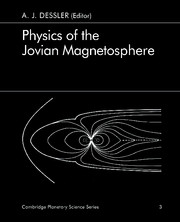Book contents
- Frontmatter
- Contents
- List of tables
- List of contributors
- Foreword
- Preface
- 1 Jupiter's magnetic field and magnetosphere
- 2 Ionosphere
- 3 The low-energy plasma in the Jovian magnetosphere
- 4 Low-energy particle population
- 5 High-energy particles
- 6 Spectrophotometric studies of the Io torus
- 7 Phenomenology of magnetospheric radio emissions
- 8 Plasma waves in the Jovian magnetosphere
- 9 Theories of radio emissions and plasma waves
- 10 Magnetospheric models
- 11 Plasma distribution and flow
- 12 Microscopic plasma processes in the Jovian magnetosphere
- Appendix A Symbols and acronyms
- Appendix B Coordinate systems
- Appendix C Jupiter and Io: selected physical parameters
- References
- Index
5 - High-energy particles
Published online by Cambridge University Press: 27 October 2009
- Frontmatter
- Contents
- List of tables
- List of contributors
- Foreword
- Preface
- 1 Jupiter's magnetic field and magnetosphere
- 2 Ionosphere
- 3 The low-energy plasma in the Jovian magnetosphere
- 4 Low-energy particle population
- 5 High-energy particles
- 6 Spectrophotometric studies of the Io torus
- 7 Phenomenology of magnetospheric radio emissions
- 8 Plasma waves in the Jovian magnetosphere
- 9 Theories of radio emissions and plasma waves
- 10 Magnetospheric models
- 11 Plasma distribution and flow
- 12 Microscopic plasma processes in the Jovian magnetosphere
- Appendix A Symbols and acronyms
- Appendix B Coordinate systems
- Appendix C Jupiter and Io: selected physical parameters
- References
- Index
Summary
In the Jovian magnetosphere, electrons, protons, and heavier ions are accelerated to energies well above 10 MeV. These energetic particles constitute a valuable diagnostic tool for studying magnetospheric processes and produce the Jovian radio emissions. In the inner magnetosphere, both the electron and proton fluxes with energies above 1 MeV build up to ~ 108 per cm2 s and constitute a major radiation hazard to spacecraft passing through this region. Surprisingly, high fluxes of energetic oxygen and sulfur (> 7 MeV/nuc) are also found in the inner magnetosphere. Of particular interest are the interactions of these particles with the inner Jovian moons and with the Io plasma torus. Throughout much of the middle magnetosphere and magnetospheric tail, highest fluxes are found in the plasma sheet, which coincides closely with the tilted dipole equator out to 45 Rj (Jupiter radii). This plasma sheet has not been identified beyond 45 Rj in the subsolar hemisphere; however, on the night side, it extends to 200 Rj. On the day side, fluxes near the equator are relatively independent of distance (15 to 45 RJ) and fall into the range 104 to 10 per cm2 s each for protons and electrons above ~ 1 MeV. In the predawn direction, proton and electron fluxes decrease by three orders of magnitude from 20 to 90 Rj (105 to 102 per cm2 s) and then remain relatively constant to the boundary layer near the magnetopause.
- Type
- Chapter
- Information
- Physics of the Jovian Magnetosphere , pp. 157 - 196Publisher: Cambridge University PressPrint publication year: 1983
- 30
- Cited by



